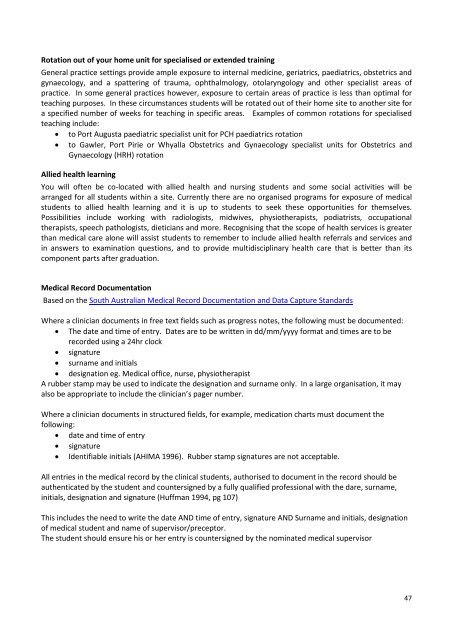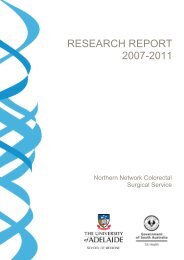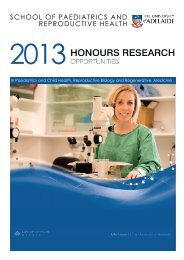Discipline of Rural Health - Faculty of Health Sciences - The ...
Discipline of Rural Health - Faculty of Health Sciences - The ...
Discipline of Rural Health - Faculty of Health Sciences - The ...
You also want an ePaper? Increase the reach of your titles
YUMPU automatically turns print PDFs into web optimized ePapers that Google loves.
Rotation out <strong>of</strong> your home unit for specialised or extended training<br />
General practice settings provide ample exposure to internal medicine, geriatrics, paediatrics, obstetrics and<br />
gynaecology, and a spattering <strong>of</strong> trauma, ophthalmology, otolaryngology and other specialist areas <strong>of</strong><br />
practice. In some general practices however, exposure to certain areas <strong>of</strong> practice is less than optimal for<br />
teaching purposes. In these circumstances students will be rotated out <strong>of</strong> their home site to another site for<br />
a specified number <strong>of</strong> weeks for teaching in specific areas. Examples <strong>of</strong> common rotations for specialised<br />
teaching include:<br />
• to Port Augusta paediatric specialist unit for PCH paediatrics rotation<br />
• to Gawler, Port Pirie or Whyalla Obstetrics and Gynaecology specialist units for Obstetrics and<br />
Gynaecology (HRH) rotation<br />
Allied health learning<br />
You will <strong>of</strong>ten be co-located with allied health and nursing students and some social activities will be<br />
arranged for all students within a site. Currently there are no organised programs for exposure <strong>of</strong> medical<br />
students to allied health learning and it is up to students to seek these opportunities for themselves.<br />
Possibilities include working with radiologists, midwives, physiotherapists, podiatrists, occupational<br />
therapists, speech pathologists, dieticians and more. Recognising that the scope <strong>of</strong> health services is greater<br />
than medical care alone will assist students to remember to include allied health referrals and services and<br />
in answers to examination questions, and to provide multidisciplinary health care that is better than its<br />
component parts after graduation.<br />
Medical Record Documentation<br />
Based on the South Australian Medical Record Documentation and Data Capture Standards<br />
Where a clinician documents in free text fields such as progress notes, the following must be documented:<br />
• <strong>The</strong> date and time <strong>of</strong> entry. Dates are to be written in dd/mm/yyyy format and times are to be<br />
recorded using a 24hr clock<br />
• signature<br />
• surname and initials<br />
• designation eg. Medical <strong>of</strong>fice, nurse, physiotherapist<br />
A rubber stamp may be used to indicate the designation and surname only. In a large organisation, it may<br />
also be appropriate to include the clinician’s pager number.<br />
Where a clinician documents in structured fields, for example, medication charts must document the<br />
following:<br />
• date and time <strong>of</strong> entry<br />
• signature<br />
• Identifiable initials (AHIMA 1996). Rubber stamp signatures are not acceptable.<br />
All entries in the medical record by the clinical students, authorised to document in the record should be<br />
authenticated by the student and countersigned by a fully qualified pr<strong>of</strong>essional with the dare, surname,<br />
initials, designation and signature (Huffman 1994, pg 107)<br />
This includes the need to write the date AND time <strong>of</strong> entry, signature AND Surname and initials, designation<br />
<strong>of</strong> medical student and name <strong>of</strong> supervisor/preceptor.<br />
<strong>The</strong> student should ensure his or her entry is countersigned by the nominated medical supervisor<br />
47





